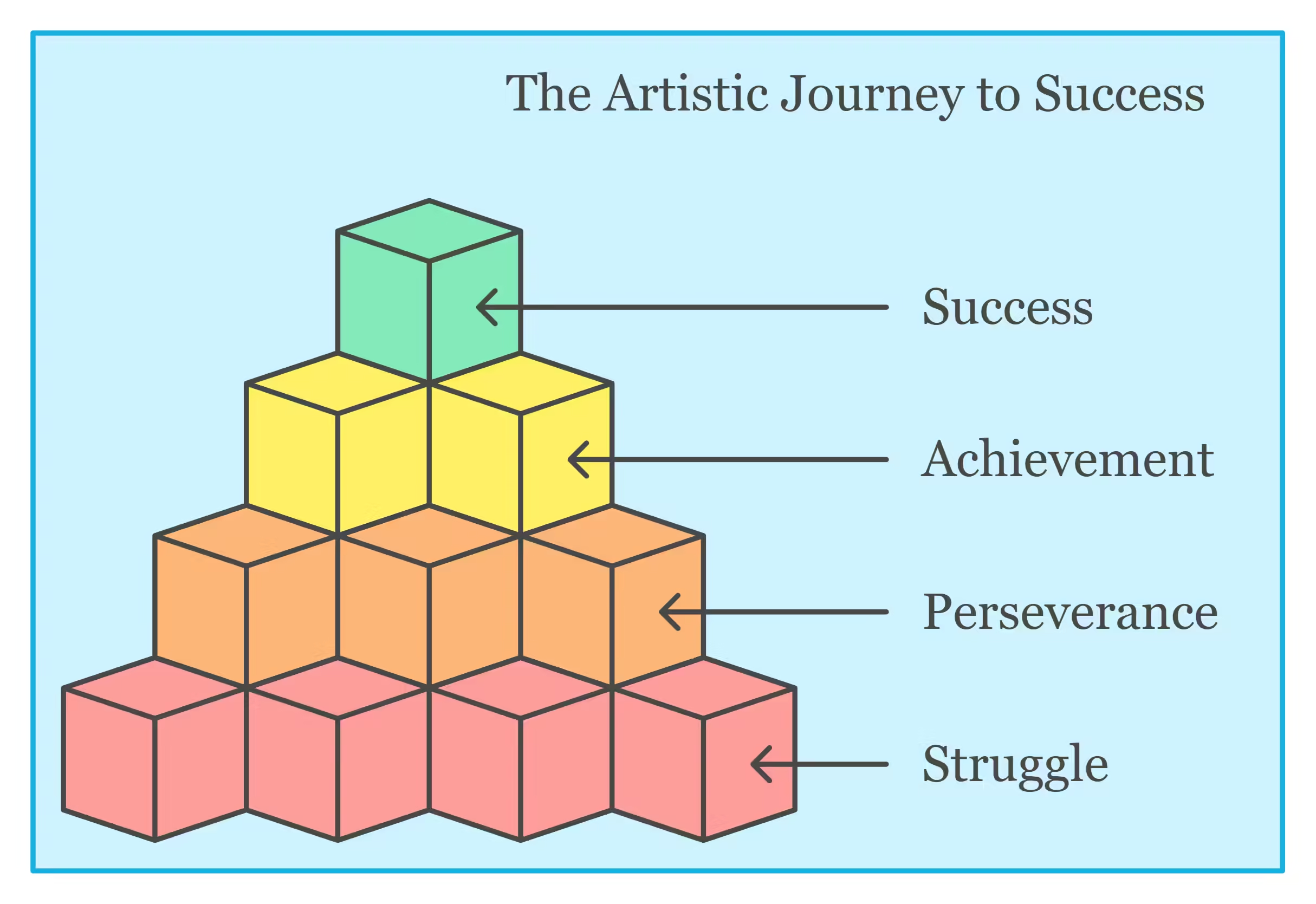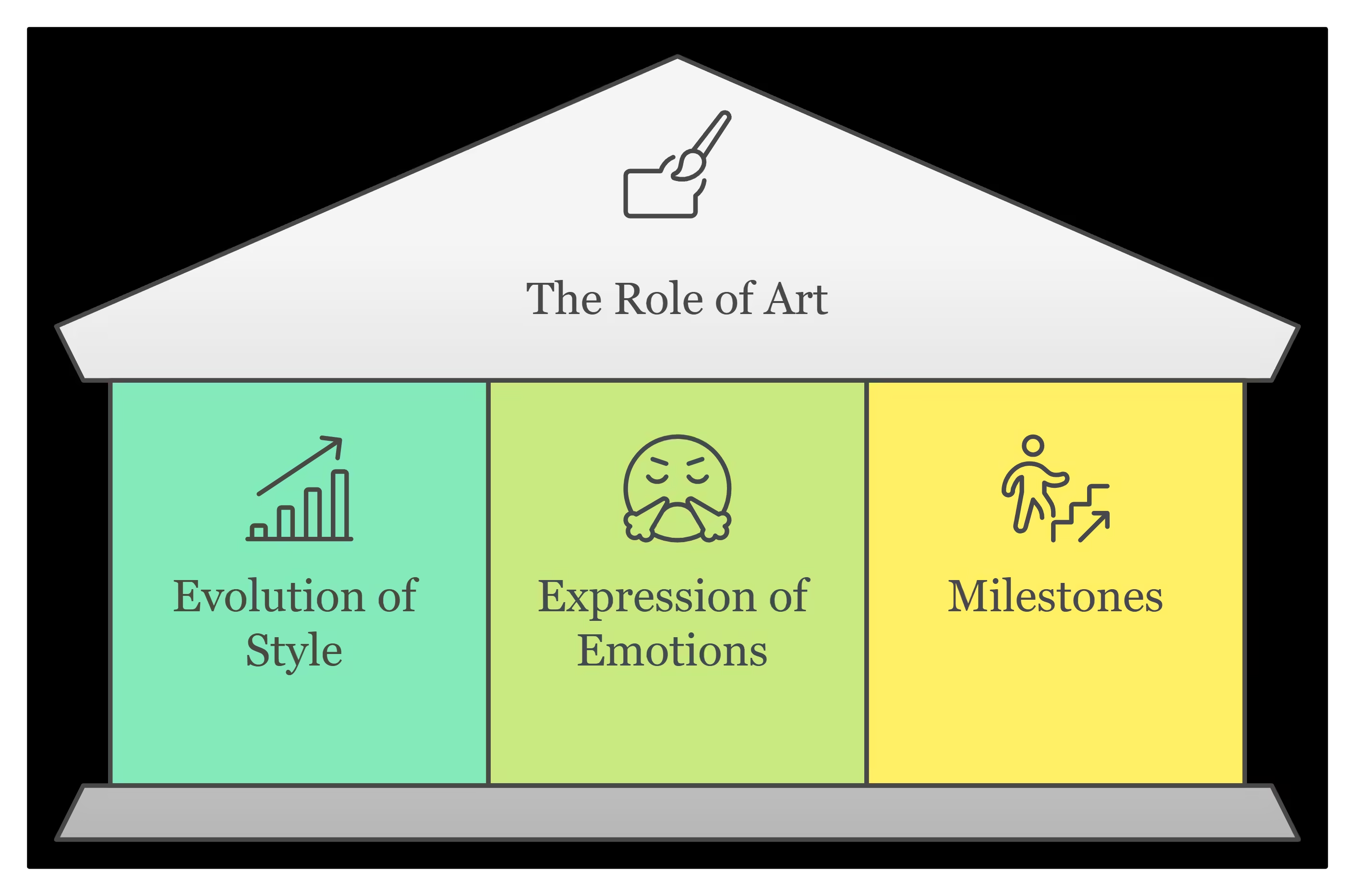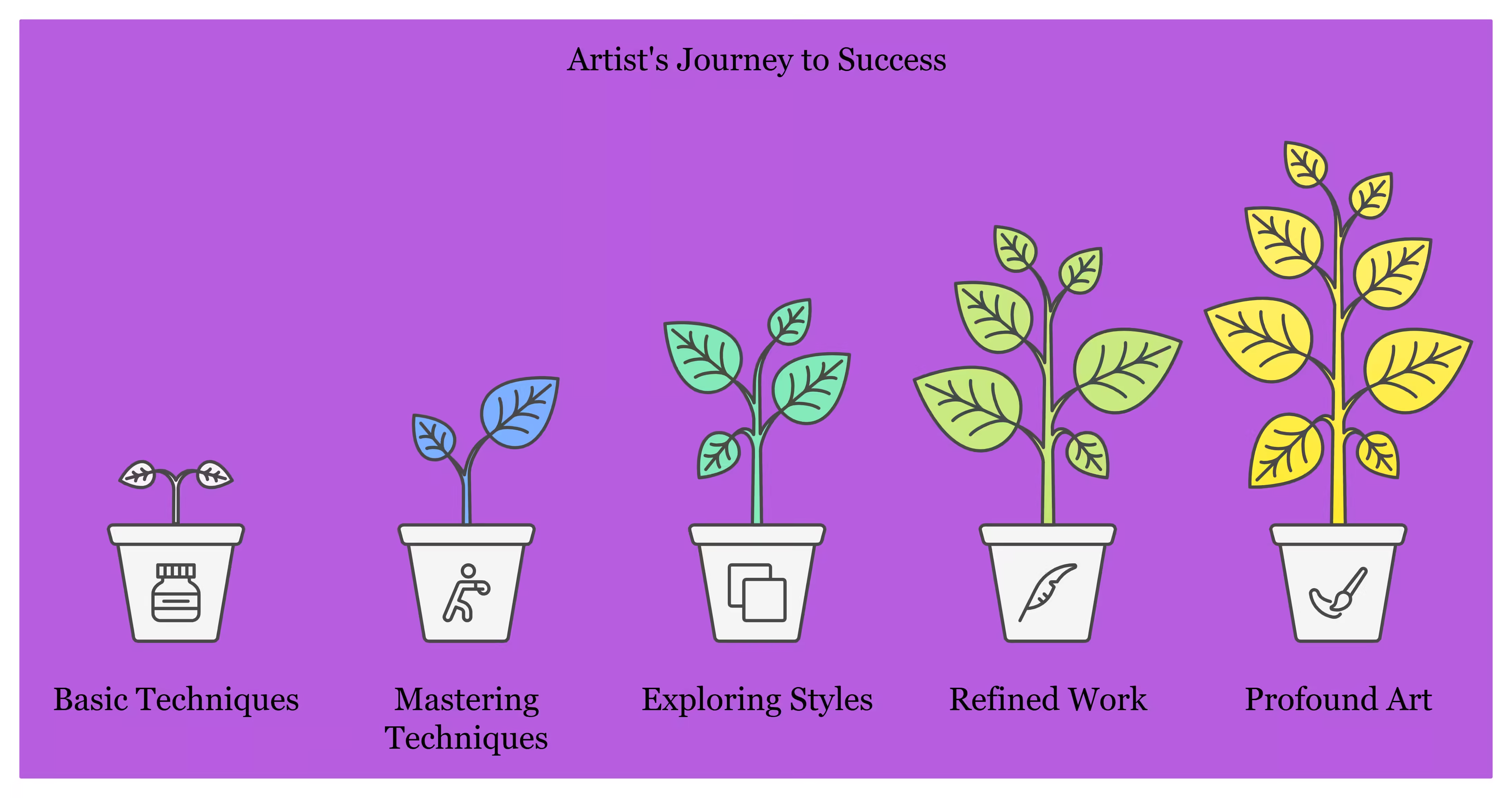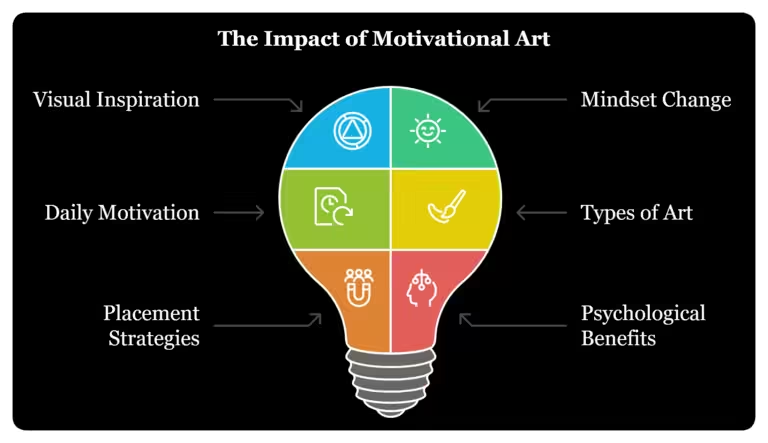Art That Reflects the Journey to Success
Success is a journey filled with challenges and triumphs. Art often mirrors this path, offering inspiration and reflection.Art That Reflects the Journey to Success
Art has a unique way of capturing the essence of success. Through various forms, it tells stories of struggle, perseverance, and achievement. Whether it’s a painting, sculpture, or photograph, each piece can represent a step on the road to success.
This blog delves into how art embodies the journey, showcasing pieces that reflect ambition, hard work, and eventual success. Understanding this connection can offer motivation and a deeper appreciation for the artistic expressions around us. Join us as we explore art that mirrors the pursuit of success, providing both inspiration and insight into the creative process.
Introduction To Success In Art
Success in art is a unique journey. Each artist has their path. Some find success early. Others take years to reach their goals. But what does success in art truly mean? And how does art reflect this journey? Let’s dive into these questions.

Defining Success
Success is different for every artist. It can be about fame. Or it might be about making a living. Some artists see success as creating meaningful work. For others, it’s about recognition.
Here are some ways to define success in art:
- Fame: Being well-known in the art world.
- Financial Stability: Making a living from art.
- Personal Fulfillment: Creating work that feels meaningful.
- Recognition: Receiving awards and positive reviews.
The Role Of Art
Art plays a big role in the journey to success. It reflects an artist’s growth. It shows their struggles and triumphs. Every piece tells a part of their story.
Here are some ways art reflects the journey to success:
- Evolution of Style: Artists develop their unique style over time.
- Expression of Emotions: Art captures feelings and experiences.
- Milestones: Each piece can mark a significant achievement.
Art is more than a product. It’s a reflection of the artist’s journey. It shows where they started and how far they have come. This makes art a powerful tool for understanding success.
Historical Perspectives
The journey to success is often portrayed through art. Artists use their work to show their struggles and triumphs. This section explores historical perspectives on this theme.
Famous Artists And Their Journeys
Many famous artists have depicted their path to success through their art. Let’s look at a few examples:
- Vincent van Gogh: Van Gogh’s art reflects his personal battles. His famous painting “Starry Night” shows his struggle with mental illness.
- Frida Kahlo: Kahlo’s works often depict her physical and emotional pain. Her self-portraits are a testament to her resilience.
- Pablo Picasso: Picasso’s “Blue Period” represents a time of poverty and depression. His later works show his growth and success.
Each of these artists used their journey to success as inspiration. Their works continue to inspire generations.
Cultural Influences
Art that reflects the journey to success is not limited to individual experiences. Cultural influences play a significant role as well.
| Cultural Influence | Artist | Work |
|---|---|---|
| Renaissance | Leonardo da Vinci | The Last Supper |
| Impressionism | Claude Monet | Water Lilies |
| Surrealism | Salvador Dalí | The Persistence of Memory |
These cultural movements shaped the artists’ work. They influenced how success and struggle were depicted in art.
Leonardo da Vinci showed the importance of religious themes during the Renaissance. Claude Monet captured the beauty of nature in his works. Salvador Dalí explored the subconscious mind through surrealism.
Understanding these cultural influences helps us appreciate the depth of their art. It shows how deeply connected art is to the artist’s journey to success.
Modern Interpretations
Art has always been a reflection of society. Modern interpretations of the journey to success are no different. Today’s artists use various mediums to tell stories of struggle, triumph, and perseverance. This section explores how contemporary artists and emerging trends depict these themes.

Contemporary Artists
Contemporary artists bring fresh perspectives to success stories. Their work is often bold and thought-provoking. Here are a few notable artists:
- Jean-Michel Basquiat: His work often explores themes of identity and success.
- Ai Weiwei: His installations challenge societal norms and celebrate resilience.
- Yayoi Kusama: Known for her polka dots, she portrays personal triumph over mental health struggles.
These artists use their platforms to inspire others. Their work serves as a reminder that success is a journey, not a destination.
Emerging Trends
Emerging trends in art reveal new ways of depicting success. Artists are blending traditional techniques with modern technology. Here are some key trends:
| Trend | Description |
|---|---|
| Mixed Media | Combining various materials to create complex pieces. |
| Digital Art | Using software to produce innovative artworks. |
| Interactive Installations | Engaging the audience in the artistic process. |
These trends reflect the evolving nature of success. They highlight the importance of adaptability and innovation in achieving goals.
Personal Narratives
Art tells stories. It captures moments, emotions, and experiences. Personal narratives in art are powerful. They reflect the journey to success. They show struggle, hope, and triumph. Let’s explore these narratives through artist interviews and stories of struggle and triumph.
Artist Interviews
Interviews with artists give us insights. We learn about their journey, inspirations, and challenges. Each artist has a unique story. Their art reflects this. Here are some key points from recent interviews:
| Artist | Key Insights |
|---|---|
| Jane Doe | Overcame financial struggles, found inspiration in nature. |
| John Smith | Used art to cope with personal loss, focuses on hope. |
Stories Of Struggle And Triumph
Behind every success, there is a story of struggle. Many artists face rejection, self-doubt, and hardships. Yet, they persist. Their stories inspire us. Here are some examples:
- Emily faced many rejections before her first gallery show.
- Mark used art to express his battle with illness.
- Sara’s work reflects her journey from poverty to recognition.
These stories show the power of art. They remind us that success comes through persistence.
Symbolism And Themes
Art often reflects the journey to success. It uses symbolism and themes to convey deep messages. These elements help viewers connect with the artist’s vision. In this section, we explore the common symbols and recurring themes found in such art.
Common Symbols
Artists use various symbols to represent success. Here are a few:
- Mountains: Climbing a mountain symbolizes overcoming challenges.
- Ladders: Ladders signify the steps taken towards achieving goals.
- Paths: Paths represent the journey one undertakes to reach success.
- Light: Light often symbolizes hope and enlightenment.
- Trees: Trees can symbolize growth and stability.
Recurring Themes
Several themes recur in art depicting the journey to success. These themes resonate with many people. Here are some:
- Perseverance: Art often portrays the struggle and determination needed.
- Resilience: Many artworks highlight bouncing back from failures.
- Transformation: The journey to success is a transformative process.
- Hope: Hope is a common theme, showing optimism for the future.
- Achievement: The moment of reaching success is frequently celebrated.
These themes and symbols help convey the complex emotions involved in pursuing success. They make art relatable and inspiring.
Impact Of Success On Art
Success has a profound impact on an artist’s work. As artists achieve their goals, their art evolves. This evolution reflects their journey, struggles, and triumphs. The changes in their art reveal much about their personal and professional growth.
Changes In Style
Artists often change their style after achieving success. They gain confidence and take more risks. Early in their careers, they might stick to familiar techniques. But success allows them to explore new styles. For example, an artist known for landscapes might start creating abstract pieces.
Success can also lead to more refined work. Artists have more resources and time to perfect their craft. They might use higher quality materials or experiment with new mediums. This transition in style is a visible marker of their journey to success.

Evolution Of Technique
Success often leads to an evolution in technique. Artists refine their skills over time. They learn new methods and perfect their existing ones. This continuous learning and improvement is a hallmark of their success journey.
Consider an artist who initially uses basic brush strokes. Over time, they might master advanced techniques. They may start using more complex methods, like layering or mixed media. This evolution in technique not only enhances their art but also reflects their growth.
Here’s a simple comparison of how an artist’s technique might evolve:
| Before Success | After Success |
|---|---|
| Basic brush strokes | Complex layering |
| Single medium | Mixed media |
| Limited color palette | Rich, varied palette |
Success impacts an artist’s work significantly. Their style and techniques evolve, reflecting their growth. This journey is evident in their art, making it more profound and meaningful.
Challenges Along The Way
Success is rarely a straight path. Many face significant challenges along the way. These obstacles shape the journey and the art that reflects it. Each hurdle offers a lesson, a story, and a piece of the puzzle in the grand picture of success.
Overcoming Obstacles
Every journey to success includes obstacles. Some are small, others daunting. But, overcoming them is crucial. Each challenge faced adds strength and resilience. This resilience often shines through in art. It tells a story of perseverance and determination.
Artists often use their struggles as inspiration. Their works display the battles they have fought. The pain and triumphs are evident in their pieces. Such art resonates deeply with viewers. It reminds them of their own struggles and victories.
Consider the story of a painter struggling with rejection. Each refusal becomes a brushstroke on their canvas. Eventually, their persistence pays off. Their art tells the tale of their journey. This narrative is powerful and inspiring.
Maintaining Authenticity
Amid the challenges, maintaining authenticity is vital. Many feel pressured to conform. But true success comes from staying true to oneself. This authenticity is often reflected in art. Genuine art connects better with its audience.
Authentic art speaks volumes. It is raw and real. It reflects the artist’s true self and journey. Such art holds a special place in the hearts of viewers. They see the honesty and relate to it on a personal level.
Consider a musician who stays true to their roots. Despite industry pressure, they maintain their unique sound. Their music tells their story authentically. This authenticity sets them apart. It garners respect and admiration from their audience.
| Challenges | Impact on Art |
|---|---|
| Rejection | Fuels determination, adds depth to art |
| Pressure to conform | Tests authenticity, strengthens unique voice |
| Financial struggles | Encourages resourcefulness, fosters creativity |
Art As Motivation
Art has the power to inspire and motivate. It speaks to our hearts and minds, pushing us to strive for success. Through vivid colors, bold strokes, and captivating imagery, art can ignite a passion for achieving our goals. It serves as a constant reminder of what we can achieve when we stay focused and determined.
Inspiring Future Generations
Art can inspire future generations in many ways. It shows the journey to success through visual stories. These stories often depict perseverance, resilience, and hard work. Young people can see these elements in art and feel motivated to follow their dreams.
Displaying artwork in schools and communities can have a profound impact. It provides daily inspiration for students and residents. They see the success journey and feel encouraged to embark on their own paths. Art becomes a silent mentor, guiding them towards their goals.
| Artwork | Message |
|---|---|
| Painting of a Mountain Climber | Reach for the top despite challenges |
| Abstract Art with Bold Colors | Embrace creativity and think outside the box |
Art As A Catalyst For Change
Art can also be a powerful catalyst for change. It can challenge societal norms and inspire action. Many artists use their work to highlight important issues and encourage positive change.
For example, murals in urban areas often depict social justice themes. These murals can spark conversations and lead to community action. People see the artwork and feel compelled to make a difference.
- Art can highlight inequality and motivate social reform.
- Environmental art can raise awareness about climate change.
- Portraits of leaders can inspire civic engagement.
Art can transform communities by encouraging dialogue and action. It can inspire individuals to work towards a better future. This makes art a vital tool for motivating and driving change.
Frequently Asked Questions
What Is Art’s Role In Achieving Success?
Art inspires creativity and persistence, essential traits for success. It reflects personal growth and the journey towards goals.
How Can Art Motivate Success?
Art evokes emotions and thoughts that drive motivation. It serves as a reminder of one’s aspirations.
Why Is Art Important For Personal Growth?
Art encourages self-expression and reflection. It helps individuals understand their strengths and weaknesses.
Can Art Impact Professional Success?
Yes, art can enhance critical thinking and problem-solving skills, beneficial for professional growth and success.
Conclusion
Art tells the story of success in a unique way. It captures struggles, victories, and dreams. Each piece inspires and motivates. You see the journey, feel the emotions. Art reminds us that success is a process. It is not just the end, but the path.
Celebrate your journey through art. Find pieces that speak to you. Let them fuel your ambitions. Reflect on your own path to success. Art is a powerful companion on this journey. Embrace it.





